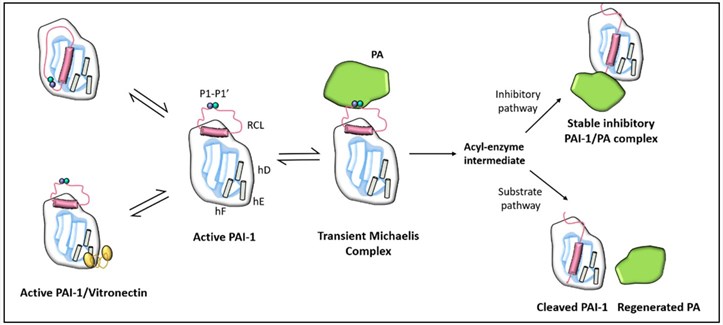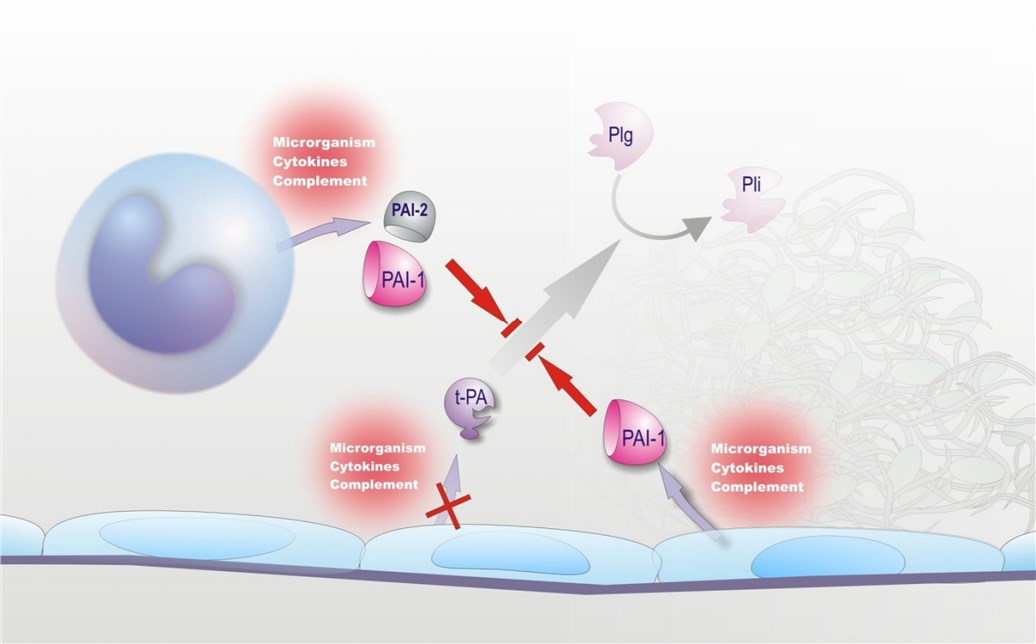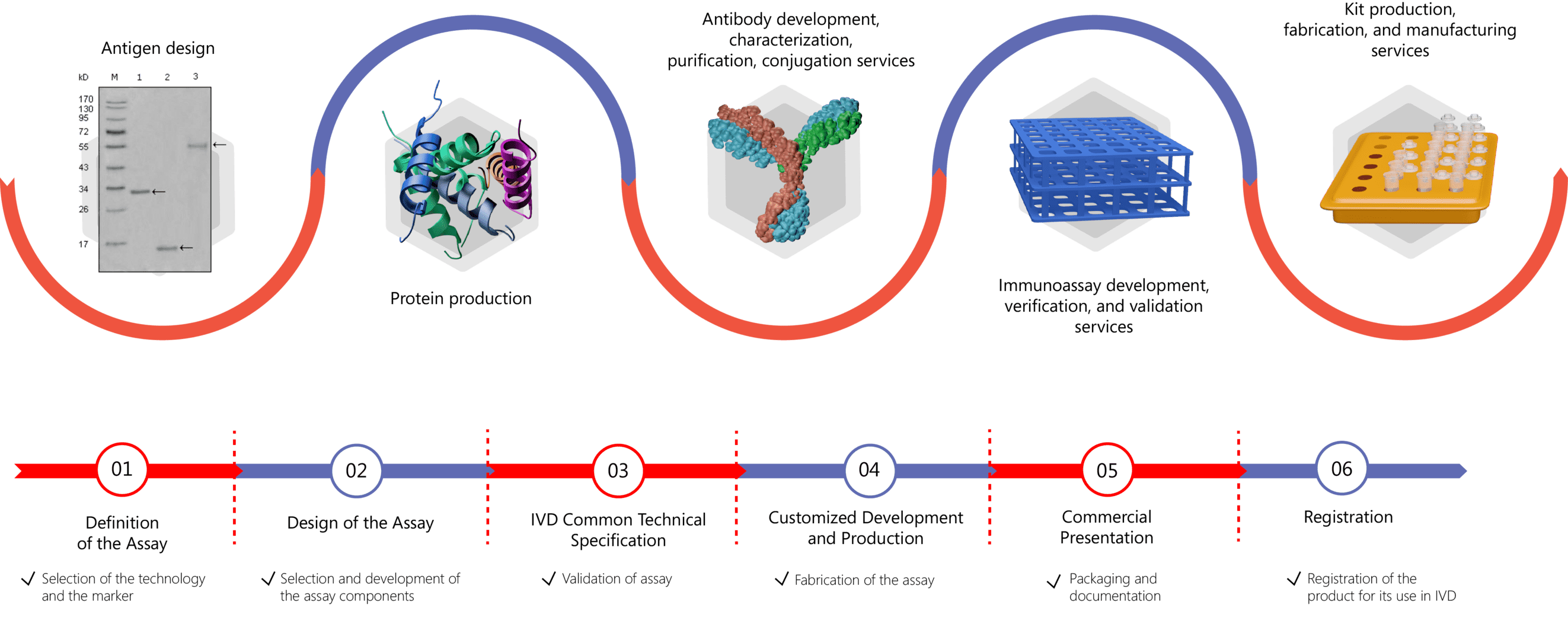Creative Biolabs, a trusted CRO company in the field of antibody development for various applications, now introduces its unique in vitro diagnostic (IVD) & immunoassay antibody development services to global clients. Our services can be customized to target different disease biomarkers, such as the plasminogen activator inhibitor type 1 (PAI-1).
Introduction to PAI-1
PAI-1 is a 50-kilodalton glycoprotein of the serine protease inhibitor (SERIPINs) family. It can be produced by various cells such as vascular endothelial cells, platelets, smooth muscle cells, fibroblasts, adipose tissue, and monocytes/macrophages. Like other SERPINs, PAI-1 inhibits its target proteinases, tissue-type plasminogen activator, and urokinase-type plasminogen activator by the formation of a 1:1 stoichiometric reversible complex. In addition, PAI-1 acts as an acute-phase protein during acute inflammation. PAI-1 is present in 3 forms in the blood circulation: an active form (mainly PAI-1 complexed with vitronectin), an inactive or a latent form (mainly present in lysed platelets and dominant in serum), and PAI-1 complexed with its target proteases.
 Fig.1 PAI-1 conformation and its interaction with vitronectin cofactor and plasminogen activators (PA).1, 5
Fig.1 PAI-1 conformation and its interaction with vitronectin cofactor and plasminogen activators (PA).1, 5
PAI-1 for Sepsis Diagnosis & Prognosis
Numerous experimental and clinical studies have revealed that the levels of PAI-1 correlate with the outcome and severity of multiple organ dysfunctions in sepsis and disseminated intravascular coagulation (DIC). Koyama et al. (2014) measured various coagulation/fibrinolysis markers in sepsis patients and reported that thrombin-antithrombin complex (TAT), PAI-1, and protein C discriminated well between patients with and without DIC. Amongst the significant diagnostic markers for overt DIC, TAT and PAI-1 were the best predictors of 28-day mortality. Hoshino et al. (2017) reported that PAI-1 can predict prognosis in sepsis patients. Therefore, PAI-1 can be a useful biomarker for evaluating the severity of sepsis.
 Fig.2 Fibrinolysis suppression in sepsis.4, 5
Fig.2 Fibrinolysis suppression in sepsis.4, 5
PAI-1 As A Biomarker for Breast Cancer Prognosis
PAI-1 plays an important role in tumor invasion and metastasis. Up-regulation of PAI-1 has been reported to correlate with poor prognosis in patients with breast cancer, suggesting that their abnormal expression on tumor tissues could contribute to tumor metastatic potential and that it might be used as a potential tissue tumor marker for breast cancer. Moreover, researchers also reported that the determination of plasma PAI-1 levels might provide important prognostic information in risk stratification and survival outcomes for patients with breast cancer.
IVD Antibody & Immunoassay Development Services Provided by Creative Biolabs
As PAI-1 can be a promising diagnostic/prognostic biomarker for sepsis and breast cancer, IVD antibodies can be developed against this biomarker to help improve their clinical diagnosis. At Creative Biolabs, we provide a full package of antibody and immunoassay development services to global clients. We have expertise in different immunoassay formats and detection methods, such as ELISA, lateral flow assay, chemiluminescence, etc. For more detailed information about what we offer for each stage of the development process, please click the links below:
- IVD Antibody Development
- Antibody Pair Development
- Antibody& Protein Conjugation
- IVD Immunoassay Development

Please feel free to contact us for more information and discuss your project needs.
References
- Altalhi, Rawan, Nikoletta Pechlivani, and Ramzi A. Ajjan. "PAI-1 in diabetes: pathophysiology and role as a therapeutic target." International journal of molecular sciences 22.6 (2021): 3170.
- Koyama, K., (2014). “Combination of thrombin-antithrombin complex, plasminogen activator inhibitor-1, and protein c activity for early identification of severe coagulopathy in initial phase of sepsis: a prospective observational study.” Critical Care, 18(1), R13. Distributed under Open Access license CC BY 2.0, mentioned by summarizing some parts of the article.
- Hoshino, K., (2017). “Usefulness of plasminogen activator inhibitor-1 as a predictive marker of mortality in sepsis.” Journal of Intensive Care, 5(1), 42. Distributed under Open Access license CC BY 4.0, mentioned by summarizing some parts of the article.
- Semeraro, Nicola, et al. "Sepsis-associated disseminated intravascular coagulation and thromboembolic disease." Mediterranean journal of hematology and infectious diseases 2.3 (2010).
- Distributed under Open Access license CC BY 4.0, without modification.
For Research Use Only.

